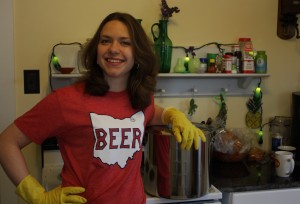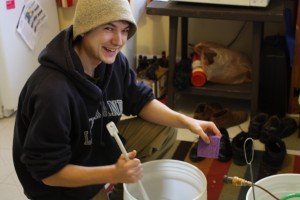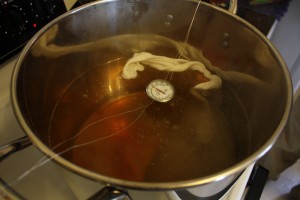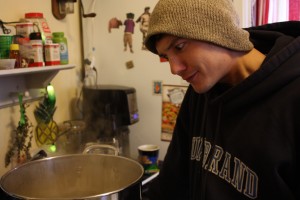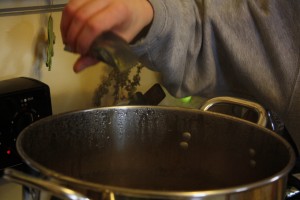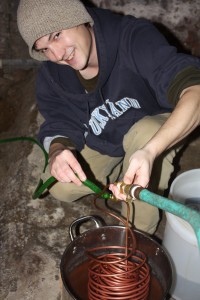By far the most time consuming step of last Tuesday’s brewing process was the argument that took place before even pouring water into the pot. Nothing serious. Just a tap water vs. Brita-filtered water disagreement; a this-is-going-to-take-forever vs. it-will-taste-like-ass-otherwise spat; a so-you’re-too-good-for-city-water-now? vs. and-here-I-thought-you-were-a-real-brewer quarrel. Turns out it takes just as long for Ben and I to reach a draw as it does to pull five gallons of water through a filtered pitcher made for drinking water. Whatever.
The first, most important ingredients for any decent batch of home brew are the beer you will be drinking and the music you will be playing while cooking it up. We chose a classic craft beer: Dogfish Head 60 Minutes, and one of my favorite snowy-afternoon albums: Modest Mouse’s The Moon and Antarctica. During the approximately seven hours it took to watch five gallons fall drip by drip into the pitcher, we used a one-step sanitizer to clean everything that would come in contact with our future brew, including both of us up to the elbows and a good deal of my sweatshirt. By then it was time for another beer and The Kills’ Blood Pressures.
The first step in which something actually happens is when you heat the water to between 150 and 160 degrees and steep the grains. The difficult part of this is, of course, taking the temperature of the water. In our case, brewing is less of a science and more an engineering project. To save us from burning our hands, Ben rigged our thermometer on wire that he wound around both pot handles so it dangled in the middle of the hot water. Clever boy, this one. The barley grains are knotted into a bag made of cheese cloth-like material that is, when floating in an increasingly dark kettle of liquid, reminiscent of a soaking pair of dirty, balled-up socks.
We removed the sodden, rather gross bag and added the first container of malt extract. The next several steps are similar to each other and involve waiting for the brew to boil, then adding hops; waiting, adding. Our instructions warned us several times, in bold, upper-case letters to watch for boil overs. To me it looked like, “blahblahblah BOIL OVERS blahblahblahblah BOIL OVERS!!” So we watched. And waited. And impatiently sent heat lasers from our eyeballs.
After the Centennial Hops are tossed in (they come in pellets that look like green rabbit food but smell way better, rather like another sort of high quality green, in fact), we muscled the kettle into our distinctly unsanitary basement where Ben had hooked up an ingenious contraption to hasten the cooling process. For an earlier brewing adventure he and his father twisted a long copper pipe into a coil through which one can run cold water. Dunk the (sanitized) coil into the wort (fancy name for pre-beer), run cold water from the washer hook-up through it, and voila! Chilled to perfection.
The wort needs to be added to another 2.5 gallons of water and stored in the low to mid 60s for over a week. Ben and I hustled upstairs to grab the rest of the (earlier- and unwillingly-filtered) water and espied a very troubling sight indeed: a lonely tub of malt extract that we should have added just after the last batch of hops. So we muscled the kettle back upstairs while running hot water over the tub in the sink to make the ordinarily thick, sticky liquid as easily dissolvable as possible. It mixed in perfectly.
We pulled the packet of yeast out of the fridge only to discover you that are supposed to shake it around to wake them all up first and let them come to and nosh for a few hours before adding them to the wort. After an impromptu shake, shake, shake dance party, we went out for a beer.
We returned downstairs with the kettle and the additional water. It was getting close to midnight. We poured the wort and water into a six-gallon bucket with a tight lid and an air-lock, which is a small clear plastic apparatus half-full of water that looks a little like a cartoon train whistle. The water inside bubbles as the feasting yeast inside passes gas. (Impolite little buggers, but you just can’t do it without ‘em.) We added the yeast to the concoction, shut the lid, and let the party begin.
Now for more waiting. When the bubbles slow to about one a minute, it will be time to keg our beer — probably 5-7 days. Next time: the name debate.

